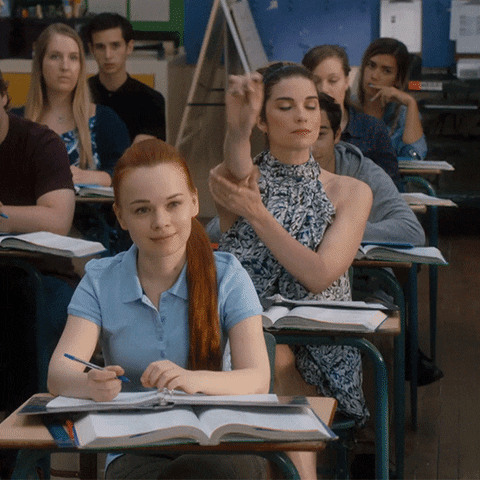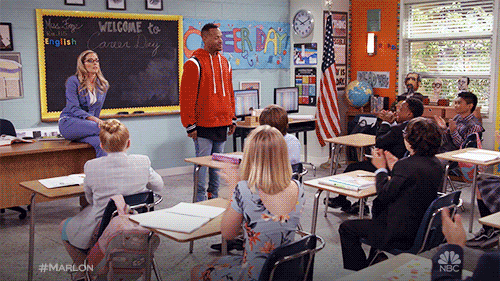5 Expectations for your Middle School Classroom
My son just started his first job at the zoo. He is a proud attendant at the giraffe feeding deck where he helps guests feed the giraffes lettuce leaves.
Imagine a couple of days into his job, his manager started yelling at him because he had one AirPod in while working. Now imagine a couple of days later he got written up for sitting on a stool in front of the fan while he told the guests what to do instead of standing and interacting with them.
Seems reasonable, right?
Flash back to the first day at the zoo and imagine the manager just gave him his polo shirt and bucket hat, and just told him to be a good employee, but didn’t explain the expectations they have for the zoo.
Now it’s not so reasonable.
It’s kind of like our classrooms, right?
We want our students to be good students, but might fail to tell them exactly what that means to us. Sometimes we assume students know what we want.
In order to make sure everyone is on the same page, I lay out these five expectations on the first day of school.
Don’t feel like reading? Check out this video!
Expectation #1 - Be present and ready to learn.
To meet this expectation, students must:
Come to class on time.
Every minute in your classroom is vital and jam-packed with awesomeness, so when a student is several minutes late, they can miss a ton. Not only that, it is a disruption when they come into the classroom and everyone has already started.
I tape a class list to the back of my door with six columns—three for tardies and three for bathroom/hallpasses (more on that later).
As soon as students start entering the classroom, I start a three minute timer. During this time, I stand at the door so I can welcome students and encourage students who are lingering at the water fountain or their locker to make their way into the classroom.
When the timer ends, I shut the door. That is the official tardy signal. If a student comes in once the door is shut, they write the date next to their name in the tardy column. The student will grab a tardy slip and move immediately to their seat. They will fill out the slip explaining their tardy and turn it in at the end of class.
When the student hands in the slip, I take a second to talk to them about why they are late, my expectations, and what will happen next time they are late. This helps solidify the expectation and that their actions have consequences.
On the third tardy, the student will receive the consequence. Usually schools have a system in place. Ours starts with a parent contact.
Minimize bathroom breaks.
Students are given three bathroom passes for the nine weeks. It might not seem like a lot, but they do have opportunities to use the restroom during homeroom, intervention, lunch, and PE. Honestly, that’s more chances than we have in a day.
If a student has to leave class for the restroom, I put the date next to their name on the same class list I use for tardies. After the third pass, I call home to make sure students do not have a medical issue that I’m not aware of.
I also set the expectation that students will not leave class during reading or whole class instruction times. They will have to wait. Since you have this expectation in place, when a student does the signal you can shake your head no. If they continue, say, “Wait about 5-10 minutes until we get done with this activity.” Unless it’s a true emergency, this strategy works.
Be prepared with materials.
Again, your class time is valuable, so students need to be ready to go when they walk in the door. When our students used lockers, they were all the time “forgetting” items and having to leave class to get it. For my students who could not seem to get it together, I made them keep their materials in the classroom.
Personally, I am not a writing utensil stickler, so I have mechanical pencils and pens in their table basket they can use if they don’t have one. I just ask that they put it back before they leave.
Stay awake during class.
Taking up space in a classroom is completely different than being present and ready to learn. Because I want my students to be active participants in class, it is vital they are awake and involved. If a student tries to lay their head down, I clap my hands and say, “Head up buttercup!” When they lift it up, I say thank you and move on. Due to the high energy and flow of the class, this is usually all it takes.
However, if a student keeps putting their head down or refuses to pick it up, I crouch down next to their seat and ask them if they want to use their one free pass. If they nod yes, I give them grace and allow them to keep their head down for the class period. I also talk to them after class to touch base and make sure they are ok. In addition, I contact the guidance counselor. If they are selecting to sleep in class, there is usually something going on that we need to get to the bottom of ASAP.
Expectation #2 - Stay in your work areas.
To meet this expectation, students must:
Use pens.
The pencil sharpener is the bane of my existence. Seriously, it is one of the few things I hate. During my first couple of years of teaching, my head would almost explode when students would get up and sharpen their pencil during instruction or reading time.
In middle school, sharpening a pencil is rarely about sharpening a pencil, it’s about trying to get attention or irritate someone. My solution? I removed the sharpener from the wall, said it broke, and banned wood pencils forever. Extreme? Maybe. But it has saved my sanity.
Students are allowed to use mechanical pencils, colored pens, and markers in class. As a byproduct of this expectation, some students have really started to express their creativity in their notebook. For example, I had a table group that started answering their constructed response questions in colors based on the mood of the chapter. Another student would put all of their text evidence used in responses in a different color. It was pretty awesome!
Keep trash at the table.
Throwing away trash is like dealing with pencil sharpening. I needed to find a way to keep students in their work area and eliminate the need to take a stroll to the trash can, so I brought the trash can to them!
I use Glad food storage containers (like these) for this purpose, and they also serve double duty as table number markers.
Through trial and error, I learned I needed to model how to use the trash cans. Seriously. On the first day, I show students how to crumple up paper and place it in the can instead of throwing it basketball style, shoving it in, or laying it on top. It’s probably just a middle school thing, but I also had to model that the trash cans are not hats. Never assume. Always explain and model so students know exactly what you expect.
Raise their hand if they need something.
You’re a rockstar, but you do not want to be mobbed like one! If students need something or have a question, then they need to raise their hand instead of coming up to you. Once one student comes up, another one will follow, and then another one and before you know it you’re surrounded like Dolly Parton in a Denny’s and can’t see what’s happening at each table.
Set the expectation that students will raise their hand and wait for you. Make sure to stay consistent. If a student does try to approach you, do not engage. You need to shake your head and point to their seat. Once they are seated with their hand up, you go to them.
Expectation #3 - Electronic devices stay out of sight.
To meet this expectation, students must:
Keep cell phones in their bag.
Even the temptation of having them in their pocket or face down on the table is too much for middle school students. In order to remove the temptation, I expect students to have them in their book bag or pencil pouch for the duration of class. I tell them that there is no need to check the time since that’s on their computer.
We practice coming into the classroom, pulling our phone out of our pocket, and placing it in our bag. If I see it out, they receive a warning. If they have it out again, I calmly say, “I’m going to take that now, but you can get it back at the end of class.” The student hands it over and we move on.
Students hand it over without arguing because we practice what it looks like if a student is on their phone and I have to take it. I let them know ahead of time that there is going to be zero drama associated with it because they know they are not meeting expectations. If it becomes a repeated issue, then I make a phone call home and turn the phone into the office.
Headphones stay out of sight.
I don’t know about you, but wireless earbuds are an issue at my school. When students walk into my classroom, I quickly scan for earbuds. If I see one, I remind students to make sure it is out of sight during class. From there, I treat it like a cellphone violation. Some students will try to say that it’s not on and they are just using it as an accessory. I say that’s super cool, but it still needs to be put away while they are in my class.
Smartwatches are only used for time.
Again, this is treated like a cellphone violation with a warning before I take it for the class period.
Expectation #4 - Keep communication respectful and appropriate.
To meet this expectation, students must:
Avoid side conversations
Avoid blurting out
Keep negative thoughts on the inside
I am not a teacher that expects complete silence. In fact, I love it when my students are talking and working together on assignments.
What I don’t love is when students stray off topic, try to have a conversation when I’m teaching, or talk to other groups.
In order to help students meet your expectations, model what appropriate conversations look like and what they don’t look like.
In addition, explain your consequences so students know what will happen when they have side conversations or blurt out.
What I do is really simple, but it works. Even for those too cool for middle school students!
If a student talks at an inappropriate time, their name goes on my board as a warning. If it happens again, it’s a check and they are moved to the focus area which is just a desk and chair near my filing cabinets. They can still complete the activities, but it is done independently and without their audience. On the third time, they earn a trip to the time-out room and a phone call home. I also take time to rearrange the seating chart for the next day in order to possibly reduce repeated issues.
Expectation #5 - Maintain a positive environment.
To meet this expectation, students must:
Be respectful of differences
Celebrate accomplishments
Encourage each other
Middle schoolers can be mean. I sometimes wonder if that is their factory setting or maybe it’s just an awkward time and they are trying to deflect so others do not focus on their perceived insecurities. Whatever the case, we have to teach and model kindness and positivity.
From the beginning, I lay out the expectation that we are kind and positive to each other. I let them know that everyone has differences, and we do not have to agree and be best friends, but we do have to be understanding and accepting of others.
If I hear a mean or negative comment, I quietly ask the student to stand in the hallway. I get the class working on something and take a couple of minutes to talk to the student. I ask them why they think they are out there. If they say they don’t know, I ask prompting questions until they admit to what they said. Usually they will then say it was just a joke. I tell them I understand that we all want people to laugh and have a good time, but doing it at the expense of others is not ok. I then ask them how they think the other person felt when they made that comment. I end it by saying that I expect more out of them and they should expect more out of themselves. I tell them to go back in, join the class activity, and find a private time to apologize.
This was a student who wrote an amazing answer, so I had him share it with the class. When he was finished, everyone cheered for him!
I take creating a safe and positive classroom environment seriously, so I nip negative comments in the bud as soon as I hear them. I also provide opportunities to celebrate students. If a student says something meaningful, insightful, or even answers a question correctly, I have the students clap and cheer. I praise effort and pause the class to say something like, “I love how hard Maddie is working on her annotations! Take a look at what she has done so far!” I hold the paper up and everyone claps.
Find small moments to celebrate and before you know it you have a class where everyone feels safe, welcome, and happy.
Final note
Consistency is key. You can lay out the expectations on day one, but if you do not follow through, constantly refer to your expectations, and have a plan in place for consequences, students will fall short.
Resources to Help You
Developing Expectations Workkit
Feel free to use my expectations or create your own to match what your ideal classroom looks like.
I do have a worksheet available for you so you can create expectations that meet your needs. Fill out the form below to access Google Doc with links to the worksheet, video, and free Google Slide template so you can present your expectations to your students on day one.
Routines and Expectations Guide
*This is available as a FREE Ebook when you join the Managing Middles Classroom Management Course! Check that out here!*
35 of my favorite routines and procedures to help you have a stress free school year!
ELA UNLIMITED
A hub where you can download this ELA Unlimited exclusive resource plus tons of other creative and engaging activities for your middle school classroom!












